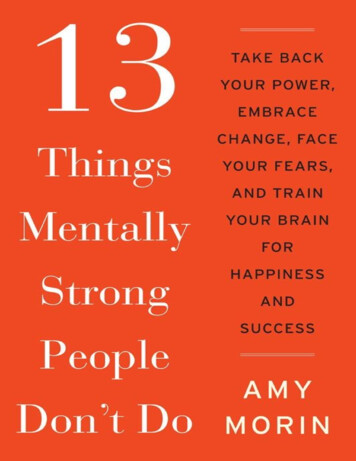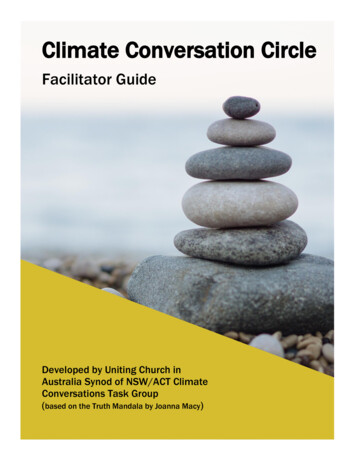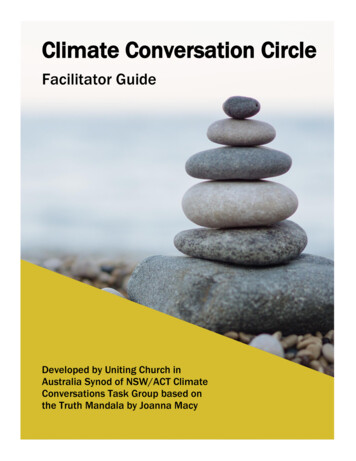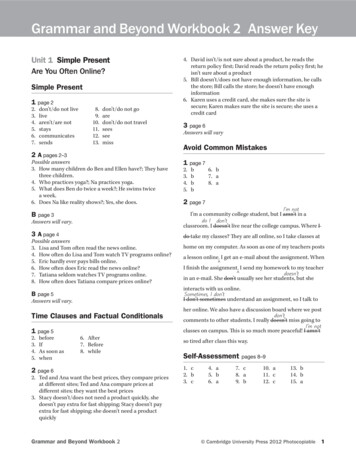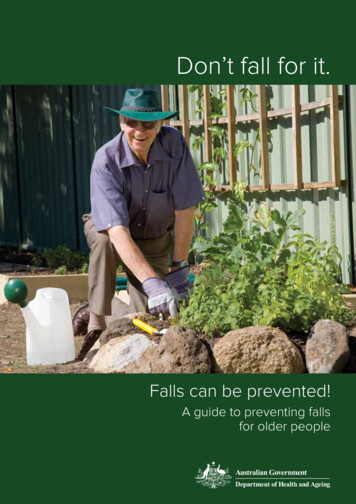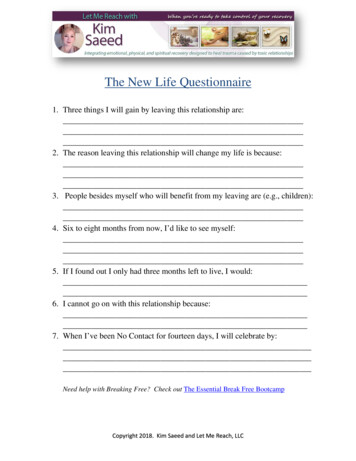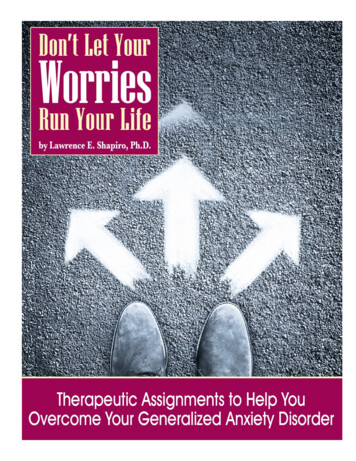
Transcription
Don’t Let Your Worries Run Your Life:Therapeu6c Assignments to Help You OvercomeYour Generalized Anxiety DisorderBy Lawrence E. Shapiro, PhDBetween Sessions Resources, Inc.Norwalk, CT1
Don’t Let Your Worries Run Your Life: Therapeu6c Assignments to Help You Overcome YourGeneralized Anxiety Disorderby Lawrence E. Shapiro, PhDCover and Interior Design by Mike Canavan 2020 Between Sessions ResourcesPermission is granted for the purchaser to copy these worksheets for personal or professionaluse, but not for resale. All other rights are reserved.Disclaimer: This book is intended to be used as an adjunct to psychotherapy. If you areexperiencing serious symptoms or problems in your life, seek the help of an experienced mentalhealth professional.ISBN: 978-1-947009-12-7Published byBetween Sessions Resources304 Main AvenueSuite 333Norwalk, CT 06851About the AuthorLawrence E. Shapiro, PhD, is a prolific author of self-help books and the inventor of more than100 therapeu6c games. Dr. Shapiro is known for his prac6cal approach to helping others. He haswri en workbooks, storybooks, card games, board games, and smartphone apps. His work hasbeen translated into twenty-seven languages.About the SeriesDon’t Let Your Worries Run Your Life is part of a series of workbooks designed to give therapistsand their clients easy access to prac6cal, evidence-based psychotherapy tools.2
Table of ContentsIntroduc6onSec6on 1. Understanding Why You Worry and How It Affects YouDo You Worry Too Much? .2Objec6ve: To help you determine how your constant worrying is affec6ng your life.Are Your Worries Realis6c?.5Objec6ve: To understand and accept that events are influenced by the laws of probabilityrather than your worries.Does Your Worrying Hurt You? .9Objec6ve: To iden6fy the physical symptoms caused by your worrying.How Do Your Worries Interfere with Your Life? .12Objec6ve: To understand how your worries keep you from doing the things that areimportant in your life.Understanding How Different Triggers Affect Your Anxiety .16Objec6ve: To iden6fy the triggers that ini6ate and fuel your anxiety.How Does Your Worrying Affect Others? .19Objec6ve: To iden6fy how your excessive worrying and anxiety is affec6ng those aroundyou.Keeping a Worry Log .22Objec6ve: To determine if there are any pa erns to when you worry and what you worryabout.Sec6on 2. Accep6ng Rather Than Figh6ng Your WorriesObserving and Accep6ng Your Worries.26Objec6ve: To begin managing your worries in healthier ways by observing and accep6ngthem.Your Worries Are Just Thoughts .30Objec6ve: To understand that your worries are just thoughts and have no par6cular power.Welcoming Mindfulness into Your Life .32Objec6ve: To bring mindfulness into your life by learning how to meditate.Calming Your Body with Progressive Muscle Relaxa6on .36Objec6ve: To reduce anxiety by learning and prac6cing progressive muscle relaxa6on.Remembering That the Movie in Your Head Isn’t Real .41Objec6ve: To accept that your worries are not based in reality.Accep6ng Your Upsefng Inner Experiences .44Objec6ve: To become aware of how you are avoiding the things that cause you to beanxious and upset.Using Visual Metaphors to Accept Your Worries and Distressing Thoughts .47Objec6ve: To detach your anxiety from your distressing thoughts.Becoming Mindful of Your World Rather Than Your Anxious Thoughts .50Objec6ve: To draw your a en6on away from your anxious thoughts by using your fivesenses to focus on your surroundings.3
Taking a No6cing Walk .54Objec6ve: To bring awareness to the present moment by taking a walk outside andno6cing your environment using all your senses.Tolera6ng and Overcoming the Physical Discomfort of Anxiety.57Objec6ve: To be er tolerate and overcome uncomfortable feelings associated with anxietyby iden6fying and replica6ng them.Understanding What You Can Control in Your Life .61Objec6ve: To increase the sense of control you have in your life by iden6fying things youcan control.Managing Catastrophic Thinking .68Objec6ve: To manage your catastrophic thinking by assessing the risk of your fearedsitua6on, and iden6fying resources in the unlikely instance the situa6on happens.What Are the Odds? .73Objec6ve: To realize that the odds of something bad happening are extremely remoteby thinking ra6onally about situa6ons you are avoiding.Tolera6ng Uncertainty .76Objec6ve: To expand the scope of your life by increasing your tolerance of uncertainty.Responding, Not Reac6ng, to Feelings .79Objec6ve: To manage difficult situa6ons more skillfully by learning about the differencebetween reac6ng and responding.Five Steps to Deal with Intrusive Thoughts .83Objec6ve: To be er handle recurring intrusive thoughts by accep6ng them rather thanfigh6ng them.Sec6on 3. Breaking the Habits That Keep You AnxiousUsing Coping Skills in Situa6ons That Make You Anxious .88Objec6ve: To reduce your anxiety symptoms by iden6fying situa6ons you avoid andlearning techniques to cope with them.Controlling Your Anxiety with a Worry Script .92Objec6ve: To face your nega6ve thoughts and upsefng feelings by wri6ng about them.Elimina6ng Your Safety Crutches.95Objec6ve: To cope with anxiety without depending on your safety crutches.Giving Up Reassurance Seeking .100Objec6ve: To cope with your worries without seeking reassurance from yourself or .others.Tracking Your Checking Behavior.103Objec6ve: To become aware of whether you deal with your anxiety by checking.Using Imaginal Exposure to Reduce Your Anxiety .106Objec6ve: To lessen the control your fears have over you by indirectly exposing yourselfto them.You Don’t Have to Be Perfect .111Objec6ve: To become more tolerant of the discomfort caused by embarrassing behaviorby deliberately doing something that may be considered inappropriate.4
Sec6on 4. Developing New Posi6ve HabitsDeveloping Self-Compassion .116Objec6ve: To become more compassionate toward yourself by envisioning an imaginaryfriend who loves and accepts you as you are.Grounding Techniques .123Objec6ve: To bring awareness to the present moment by learning and prac6cinggrounding techniques.Reducing Anxiety with Your Breathing .126Objec6ve: To interrupt the cycle of worry and anxiety by paying a en6on to yourbreathing.Embracing Your Worries with Humor .130Objec6ve: To reduce your anxiety through the use of humor.Prac6cing Self-Care and Self-Calming .133Objec6ve: To develop a more posi6ve aftude toward life, control your anxiety, and feelmore at peace by prac6cing self-care and self-calming.Filling Your Mind with Posi6ve Thoughts .136Objec6ve: To reduce anxiety and develop a greater sense of well-being by thinkingposi6vely.Overcoming Anxiety with the Help of Exercise .139Objec6ve: To iden6fy types of ac6vity you can consistently engage in to decreaseanxiety.How Diet Affects Your Anxiety .142Objec6ve: To improve your diet to decrease anxiety symptoms.Reducing Anxiety by Gefng More Sleep .146Objec6ve: To improve your sleep habits in order to decrease anxiety symptoms.Preven6ng and Managing Lapses in Overcoming Your Anxiety .149Objec6ve: To iden6fy early warning signs of a lapse so that you can respond .appropriately.Does Your Anxiety Make You Depressed? .151Objec6ve: To determine if you need treatment for depression as well as anxiety.Appendix A: Medica6on and Your AnxietyTen Facts You Should Know About Medica6on for Anxiety .156Keeping Track of How Medica6on Affects You .157Appendix B: Anxiety and the COVID-19 PandemicCoping with Face Mask Anxiety .160Objec6ve: To iden6fy ways to help you overcome fear and anxiety related to wearing aface mask.Coping with Dental Anxiety During the Pandemic .163Objec6ve: To reduce your dental anxiety during the COVID-19 pandemic througheduca6on and prepara6on.Coping with Sleep Problems During the Pandemic .167Objec6ve: To develop a habit of focusing on feelings during the day to improve your .sleep.Protec6ng Yourself from Anxiety Contagion During the Pandemic .171Objec6ve: To reduce the likelihood of pandemic-related “anxiety contagion.”5
Introduc6onIs your life being taken over by your constant worrying? Do you find yourself worrying throughthe day about money, health, family, work, or other issues? Do you find it difficult to controlyour worrying even though you know it is not helping you? Do you expect the worst in almostany situa6on, even when you are aware that there is no real reason for concern?If you answered yes to most of these ques6ons, you likely have generalized anxiety disorder(GAD), a problem that affects over 3 percent of the US popula6on. GAD is diagnosed when aperson finds it difficult to control worrying on more days than not for at least six months andhas three or more of the following symptoms: Feeling nervous, irritable, or on edge Having a sense of impending danger, panic, or doom Having an increased heart rate Breathing rapidly (hyperven6la6on), swea6ng, and/or trembling Feeling weak or 6red Having difficulty concentra6ng Having trouble sleeping Experiencing gastrointes6nal problemsBut you don’t have to let your worries ruin your life! You can live your life in the moment. Youcan do things and go places whenever you want. You can live a fulfilling and happier life in just afew months. This book can help. Its four main sec6ons provide forty-one worksheets to helpyou overcome your GAD. Although the exercises can be used on your own, we highlyrecommend you use this book with a qualified psychotherapist who can guide you.The assignments can be thought of as therapy homework. Your therapist can explain why eachexercise is important and also guide you in learning new emo6onal, cogni6ve, and behavioralskills that can stop your excessive worrying.The Worry ParadoxIf you are like most people with GAD, you have probably spent countless hours trying to findways to stop worrying. You may try to talk yourself out of worrying, saying words like, “Myworrying doesn’t help me,” over and over again. You may try to distract yourself from worryingby binge-watching TV or doing something healthier, like exercising.But these efforts to stop your worrying don’t help, do they? If they did, you probably wouldn’tbe reading this book. In fact, studies have found that the more you try to stop worrying, themore you worry! This is what psychologists call the “worry paradox.” A paradox is somethingthat contradicts itself. You would think that trying to stop worrying would help you, but in fact itoren makes your worrying worse. This paradox is oren illustrated by a simple experiment youmight want to try right now.6i
For one minute, don’t think about a giant pink elephant in your room.If you are like most people, as soon as you try not to think about a pink elephant, it appears inyour mind. And the harder you try not to think about it, the more likely that elephant is to bethere.Worries work the same way. The more you try to distract yourself from your worries, the moreyou tell yourself it is useless to worry, the more you try to fight your worries by replacing themwith other thoughts, the more your worries will s6ck around.So instead of trying to get rid of your worries, this workbook will help you understand yourworries and accept them. And when you learn to accept them, you take away their power, andyour worries stop being paramount in your life. Will you s6ll worry some6mes? Of course.Everyone does. But this workbook can help you reduce your worries to a “normal” level andgive you the skills you need live a happy and fulfilling life without being tormented by constantanxiety.What You Will Find in This WorkbookThis workbook will take you through four main steps to overcoming your worries. Each stepcorresponds to a sec6on of the workbook where you will learn specific skills on your journey toovercoming your anxiety disorder.Sec6on 1: Understanding Why You Worry and How It Affects YouThe ac6vi6es in this sec6on will help you get perspec6ve on your worrying and how it affectsyour life, including the people you care about.Sec6on 2: Accep6ng Rather Than Figh6ng Your WorriesThe techniques in this sec6on will help you learn to tolerate having worrisome thoughts andhelp you understand that thoughts are just thoughts and have no special power over you.Sec6on 3: Breaking the Habits That Keep You AnxiousYou most likely have habits that support your worrying. The techniques in this sec6on will helpyou recognize and change those habits.Sec6on 4: Developing New Posi6ve HabitsThis sec6on will help you learn alterna6ve habits that help you live a more worry-free life.The workbook ends with two appendices: one where you’ll find addi6onal informa6on that canhelp you reduce your anxiety, and one that addresses coping with anxiety during the COVID-19pandemic.7ii
Crea6ng a Permanent ChangeThere is no right or wrong place to start this workbook. All the techniques in it will be helpful. Ifyou are in therapy for your anxiety, you should discuss where to start with your therapist orcounselor, who may suggest specific techniques that will have the most immediate impact.Learning new skills takes prac6ce. Above all, it is important to be pa6ent with yourself andpersist in using these techniques even though they may at 6mes be difficult. The treatment ofanxiety, or any mental health problem for that ma er, can quite literally change the way yourbrain works, but this can take some 6me.We wish you the best in working to overcome your anxiety. If you are looking for addi6onalresources, we recommend using the website of the Anxiety and Depression Associa6on ofAmerica, which can be found at h ps://www.adaa.org/.8iii
Sec6on 1. Understanding Why You Worryand How It Affects You1
Do You Worry Too Much?Objec6ve: To help you determine how your constant worrying is affec6ng your life.You Should KnowEveryone worries some6mes. Thinking about the future, even when it makes you anxious, is anormal biological response to a perceived threat and warns you when you need to take ac6on.However, you might worry all the 6me, so much that your excessive worrying interferes withyour normal daily ac6vi6es—robbing you of experiencing a full and happy life.Excessive worry is oren associated with depression and other emo6onal problems. Excessiveworry can be a significant stress in your life and even contribute to physical problems. Excessiveworry can also interfere with your rela6onships at home, at school, and even at work. If youconstantly hear people say, “Why do you worry so much?” you can assume your worrying hasbecome a problem.What to DoCheck off the statements that apply to you and write down at least one example for eachstatement you check.I constantly worry about something over and over again.I no6ce that my muscles ache from so much tension.My worrying makes me restless or antsy.My worrying affects my rela6onships and social ac6vi6es.2
My worrying affects my work or school performance.I’m driving my family or friends crazy with my worrying.People tell me I worry too much.My worrying causes me to lose sleep.I have a hard 6me concentra6ng because I worry so much.My worrying causes me to be irritable, and I think I take this out on others.I have several habits that I know don’t make much sense, but they reduce my worrying.3
What is one aspect of your worrying that interferes with your life?What would be different in your life if you no longer worried so much?Reflec6ons on This ExerciseHow helpful was this exercise?(1 not very helpful, 5 moderately helpful, 10 extremely helpful)What did you learn from this exercise?What else can you do to make progress in this area?4
Are Your Worries Realis6c?Objec6ve: To understand and accept that events are influenced by the laws of probabilityrather than your worries.You Should KnowJust because something is possible does not mean it is probable. People with anxiety disordersare oren consumed with the idea that something terrible will happen if they fail to act in acertain way. They become so overwhelmed by anxiety that they oren do not take the 6me torealis6cally examine whether what they fear most is likely to come true. For example, it ispossible you could be struck by lightning, but sta6s6cally it is not probable. It is also possible youcould win the lo ery, but sta6s6cally it is not probable. Anxiety disorders can make it difficult todis6nguish between what is possible and what is probable.What if you apply the theory of probability to your anxiety? Probability is the likelihood anevent will occur. Of course, it is always possible your fears may be warranted, but is it probable?Most people with anxiety disorders imagine the worst outcome and act accordingly to preventit. But think about this: if it is possible for the worst outcome to occur, it is equally possible forthe best outcome to take place.Consider Marcia’s situa6on. Marcia was sure she would give a terrible presenta6on at work andfeel embarrassed. She prac6ced giving the presenta6on to a friend, prac6ced in front of amirror, and even took a video of herself and watched it again and again. Every 6me sheprac6ced, she increased the probability she would give a good presenta6on.What to DoThis exercise will help your ra6onal mind be er understand the concept of probability. You willbegin by thinking of something you worry about because you think it could have a terribleoutcome. Then you will look at nine other possible outcomes. With each outcome, you willconsider the likelihood (probability) that the outcome will happen and why.Begin by wri6ng down the worst outcome you can imagine. Then write down other possibleoutcomes. Try to write down at least nine other possible outcomes, making sure at least threeare posiCve ones.Now go back and write in the probability—low, medium, or high—that each outcome will occurand the reasons for your probability es6mate. Here are some examples from Marcia’sworksheet:5
Possible outcomesProbabilityReasons/commentsI will make an idiot out ofmyself and get fired.LowThis is not probable because I spent more than10 hours pracCcing the presentaCon. Andbesides, my work is really appreciated, so whywould I be fired for screwing up apresentaCon?I will spill a glass of water onmy presentaCon.LowI’ll take a sip of water before the presentaConand won’t even have a glass of water nearwhere I am speaking.I’ll get a standing ovaCon.LowEven if I give a great presentaCon, the subjectis not that exciCng!People will be interested inwhat I say, and someone willgive me a compliment.HighThis is what happened before.I’ll have to go to theLowbathroom in the middle of thepresentaCon.This has never happened, and I’ll use thebathroom before I start.I’ll talk too soOly, andMediumsomeone will ask me to speakup.This has happened before, but it wasn’t toobad.6
Now try this for yourself.Possible outcomesProbability7Reasons/comments
Did you find yourself becoming anxious during this exercise? What thoughts came to mindwhen doing this exercise? Be specific.Write down some worries where you need to examine the probability of the outcomes.Reflec6ons on This ExerciseHow helpful was this exercise?(1 not very helpful, 5 moderately helpful, 10 extremely helpful)What did you learn from this exercise?What else can you do to make progress in this area?8
Does Your Worrying Hurt You?Objec6ve: To iden6fy the physical symptoms caused by your worrying.You Should KnowThe excessive worrying associated with generalized anxiety disorder (GAD) can cause you tohave physical problems, just like other form of stress. These common physical symptoms areassociated with excessive worrying: restlessness or feeling keyed up or on edge being easily fa6gued muscle tension dizziness headaches stomachaches shortness of breath dry mouthExcessive worry is experienced by your body as stress, so your body reacts by producing stressbiochemicals, including cor6sol, adrenaline, norepinephrine, and others. An excess of thesebiochemicals is associated with high blood pressure and heart disease, lowering of the immunesystem, and a variety of other serious illnesses.Besides the direct physical problems that excessive worrying can cause, constant worrying canalso lead to habits that cause poor health, including overea6ng or other dietary problems, sleepdisturbances, and overuse of alcohol or drugs.What to DoThis worksheet is designed to help you examine how your worrying is affec6ng your health.Note: If you have ongoing physical complaints, you should always see your doctor to find out ifthere is some medical cause to these problems and if these physical problems require treatment.9
Begin by wri6ng down your common physical problems that you think might be associated withyour worry and anxiety. Note how oren they occur: daily, weekly, or monthly. Next, rate yourphysical problems on how these symptoms are affected when you feel worried, using a scalefrom 0 to 10, where 0 not at all affected by my worrying, and 10 always gets worse when Iworry. Finally, add any comments regarding how your worrying affects your physical problems.Physical problemFrequencyRa6ngCommentsAddressing the physical problems associated with your worrying requires an overallcommitment to be er health habits. It is important to understand that there is always a mindbody connec6on to your mental health problems, and that working on your emo6onal healthand physical health will always result in the quickest improvement.Write down ways you can improve your physical health problems. If you an6cipate havingdifficulty in making improvements in these areas, you may want to consult an appropriatehealth professional.10
SleepExerciseNutri6onRelaxa6on ExercisesReflec6ons on This ExerciseHow helpful was this exercise?(1 not very helpful, 5 moderately helpful, 10 extremely helpful)What did you learn from this exercise?What else can you do to make progress in this area?11
How Do Your Worries Interfere with Your Life?Objec6ve: To understand how your worries keep you from doing the things that are importantin your life.You Should KnowThinking about the future is different from worrying. Unlike other animals, humans have a brainthat is wired to think about the future. There is nothing wrong with thinking about what mighthappen in the future, as long as this thinking is based in reality and does not interfere with yourliving life to the fullest and enjoying each day. However, if you find that excessive worrying isinterfering with your life and causing you to be anxious, it is a problem you need to consideraddressing.Worrying can shape your whole life without your even realizing it. You might be so used toworrying all the 6me that you fail to realize how it is affec6ng your day-to-day choices.Some6mes you might even jus6fy your worrying by saying that it shows you are concernedabout others or it helps you focus on things that can be prevented. Again, it is okay to worrysome6mes. But think about whether your excessive worry has become a habit you just take forgranted. Has it become such a part of your life that you worry about even the smallest of thingsthroughout the day? Can you control your worrying, or does it prevent you from experiencingyour life in the moment?What to DoUse the worksheet on the next page for one week to try to catch each 6me you think “What if ,” and write down how this worry is keeping you from living your life to the fullest.Example:Your worry: What if I ask for a raise and my boss laughs at me?How is your life being affected? I might never get a raise if I don’t ask for it, and I could reallyuse the money.12
Week ofYour worryHow is your life being affected?13
Do you see a pa ern to your worrying?What is something in your past you wish you had done but did not because you worried toomuch?Write down two things you would like to do that your worries are holding you back from.1.2.Write down two things that could mo6vate you to try these things despite your worrying; forexample, encouragement from a friend or the desire to do something fun with your family.1.2.What ra6onal statement can you make to yourself about your worrying?14
Reflec6ons on This ExerciseHow helpful was this exercise?(1 not very helpful, 5 moderately helpful, 10 extremely helpful)What did you learn from this exercise?What else can you do to make progress in this area?15
Understanding How Different Triggers Affect Your AnxietyObjec6ve: To iden6fy the triggers that ini6ate and fuel your anxiety.You Should KnowMany things can trigger worry and anxiety, and many of your worries may have several differenttriggers. Your worries might begin with an external situa6on or event, and an6cipa6ng thisevent triggers worrisome thoughts, memories, and physical sensa6ons. These triggers canoverlap and even seem like they are happening at the same 6me. When anxiety feelsoverwhelming, it might even trigger a panic a ack, making it hard to recall how this episodestarted.What to DoThink about the last 6me you felt anxious. The circles on the next page represent four differentkinds of triggers. Write down where you think your anxiety started: with an external event, athought, a memory, or a physical sensa6on. Then draw an arrow to the next circle (trigger), andwrite in what happened, and so on.You might discover that only two types of triggers are part of your anxiety reac6on, or you mightsee that all four types of triggers are involved. Make copies of this diagram to fill out every 6meyou feel anxious. See if there are any pa erns to your anxiety triggers.16
When you feel anxious, write down the triggers that seem to start and fuel your anxiety. Thendraw an arrow to the next circle and fill in what happened, and so on.External EventPhysical SensationThoughtMemory17
What was the most common thing that triggered your anxiety: an external event, a thought, amemory, or a physical sensa6on? Did you iden6fy pa erns? Explain.Did you try anything to stop one trigger from connec6ng to another? Describe.What can you do to break any pa erns you iden6fied?Reflec6ons on This ExerciseHow helpful w
Lawrence E. Shapiro, PhD, is a prolific author of self-help books and the inventor of more than 100 therapeuc games. Dr. Shapiro is known for his praccal approach to helping others. He has . Objec6ve: To reduce anxiety and develop a greater sense of well-being by thinking posi6vely. Overcoming Anxiety with the Help of Exercise.

